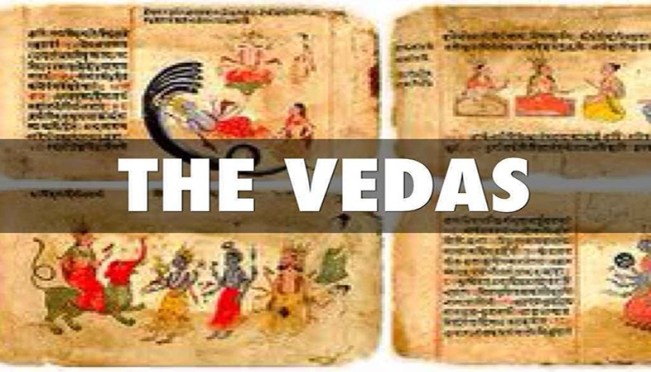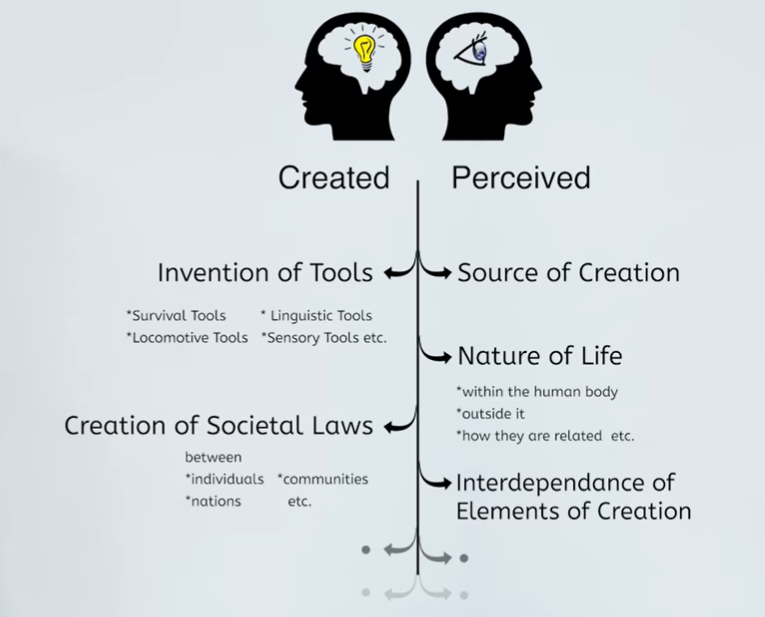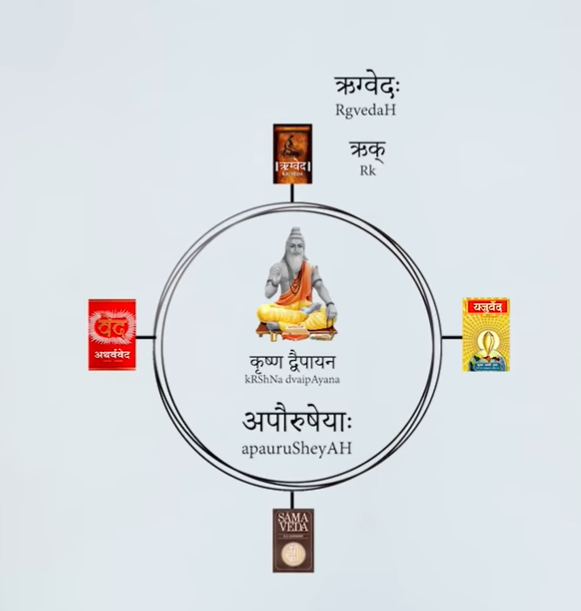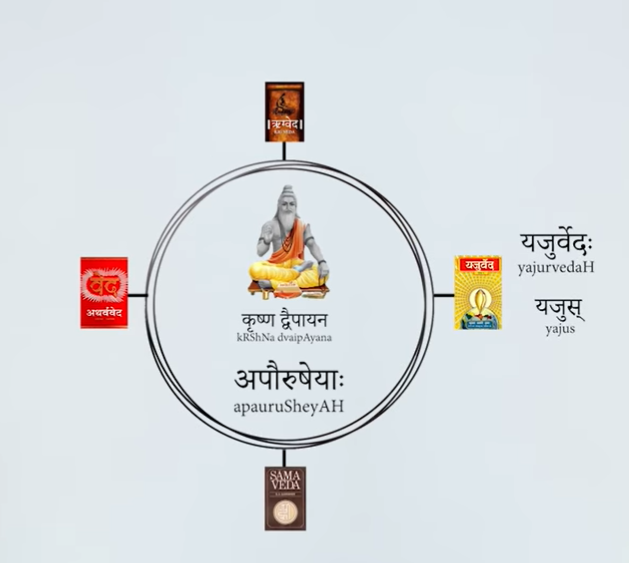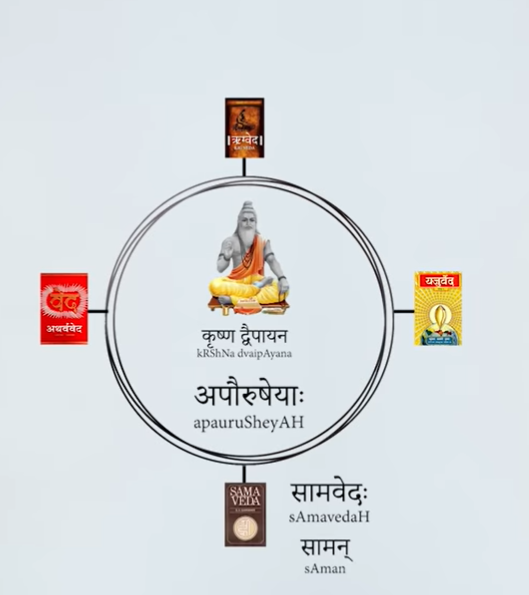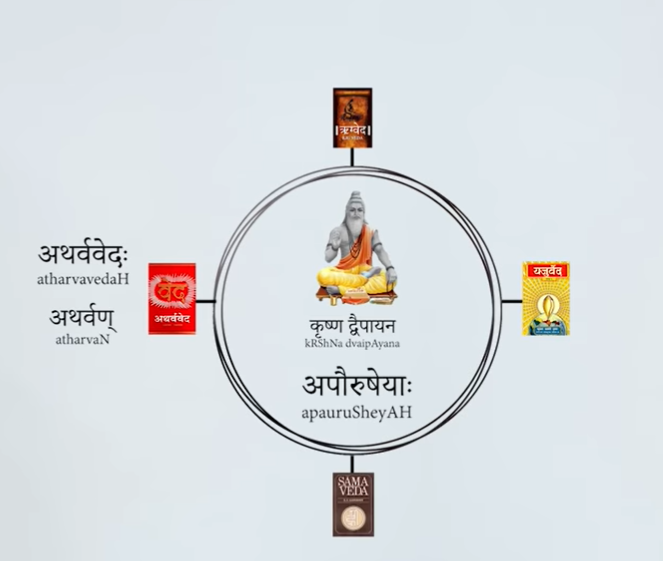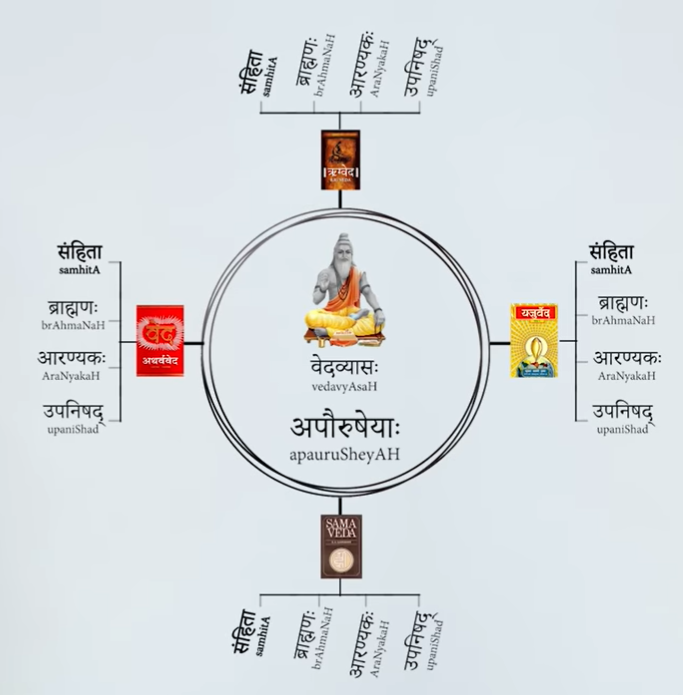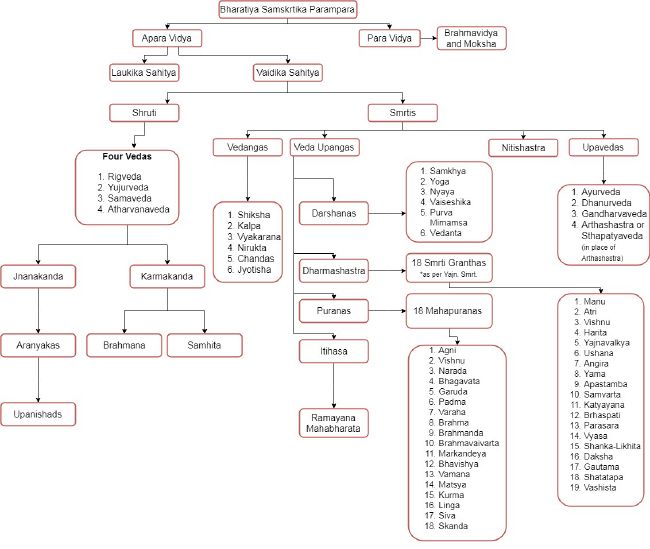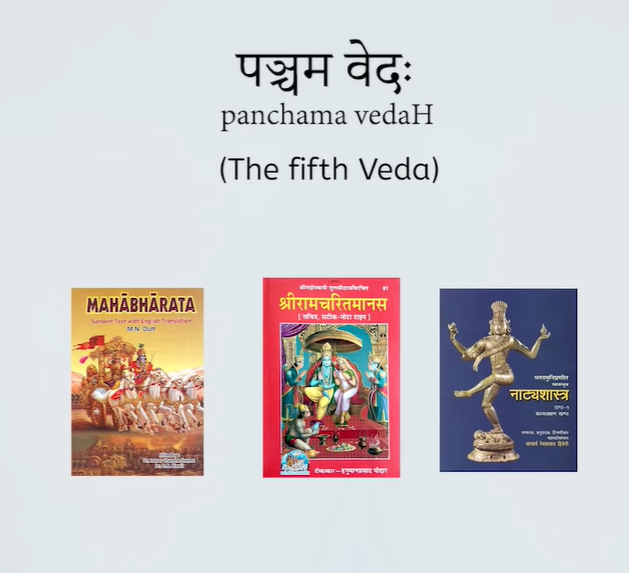1/ Thread on understanding Veda
The word वेद (Veda) comes from the root sound विद् (Vid), which literally means, 'to know' or 'to understand'.
{Credit: The Sanskrit Channel)
The word वेद (Veda) comes from the root sound विद् (Vid), which literally means, 'to know' or 'to understand'.
{Credit: The Sanskrit Channel)
2/ This is the root sound from which words like Vidya (विद्या) which means learning, and Vidvaan (विद्वान्) and Vidushi (विदुषी), which mean a learned-man and a learned-woman, come from. The literal meaning of the word Veda is just 'Knowledge'. Knowledge of what?
3/ Of anything and everything in existence. This is the context in which it is said, अनन्ता वै वेदाः, which means the systems of knowledge are infinite.
But we all have heard that there are four Veda, each of which has four components of their own.
But we all have heard that there are four Veda, each of which has four components of their own.
4/ You might have also heard that there are 6 fields of study to understand these four components of the Veda. If the Veda are infinite (अनन्ता), how did this classification came about?
5/ How many such components of study actually exist, and how to go about exploring each of them systematically?
6/ In the tradition of Sanatana Dharma, whenever people realized something of immense value in their lives, they did not immediately hide it and patent it, they sought others who are in the pursuit of that same knowledge, to pass it on to them and establish a lineage, to…
7/ …pursue that knowledge system further. This is called as Guru-Shishya Parampara (गुरु शिष्य परम्परा). All of such systems of knowledge could be classified into two different categories.
8/ Those which are thought up, and created through human intellect, and those that are perceived and realized by the human mind.
9/ The first category includes knowledge systems like the creation and use of various tools of survival, like hunting and farming tools, tools to enhance the external sense perceptions, and methods to make life more secure and comfortable.
10/ It also includes knowledge systems like the rules of societal behavior and function, the responsibilities and duties between the individual components of a family, of a society, and so on...
11/ And then there are knowledge systems, which are existential, like how the creation came about, how life functions within the human body, and outside it, the relationship between creatures and the forces of creation, the purpose and possibilities that this relationship…
12/ …comes with, and so on...
While the first kind of knowledge systems are subject to change with the times one lives in, and the society around, the second kind of knowledge systems stay valid and true irrespective of societal structures and the needs of the time.
While the first kind of knowledge systems are subject to change with the times one lives in, and the society around, the second kind of knowledge systems stay valid and true irrespective of societal structures and the needs of the time.
13/ This is the knowledge that is not a product of the human mind. We might perceive it, and put it to use, but it is not a product of human thought and imagination. This is the context in which these systems of knowledge, are called as अपौरुषेयाः (not-man-made).
14/ The son of sage पराशर (Parashara) called कृष्ण द्वैपायन (Krshna-Dvaipayana) took all of these अपौरुषेयाः and classified them into four broad groups.
The first of them is called as the ऋग्वेदः (Rig-Veda).
The first of them is called as the ऋग्वेदः (Rig-Veda).
15/ It is a compilation of various hymns, each of which, is called as ऋक् which means descriptive words of praise.
16/ The hymns of ऋग्वेदः (Rig-Veda) describe, and praise the properties of various natural elements around us, giving them personified forms of Agni, Indra, Mitra, Varuna, Soma, and so on...
17/ The second classification is called as the यजुर्वेदः (Yajur-Veda), where the word यजुस् literally means practice or a ritual. This Veda is a realization of the power of performing rituals.
18/ It consists of instructions as to how to conduct various kinds of rituals, which are conducive for specific aspects of human well-being. In terms of textual content, it shares a lot of hymns in common with the ऋग्वेदः (Rig-Veda).
19/ The third classification is called as the सामवेदः (Sama-Veda), where the word सामन् literally means a gentle song. This Veda is a realization of the power of musical notes. It delves into the utterance of specific chants to a set tune.
20/ This Veda is seen as the origin of the field of sangeet (music) in Sanatana Dharma. This Veda too shares a lot of common text with the ऋग्वेदः (Rig-Veda), but in a more practical context of chanting it as a song.
21/ The fourth and the final categorization, called अथर्ववेदः (Atharva-Veda) has a lot of content which is unique from the rest of the three.
22/ But the realizations contained within it, as perceived by sage अथर्वन्, are still अपौरुषेयाः (Apaurusheyas), or not-made-up in the human mind. This Veda deals with the knowledge of handling life at a more physical level of existence.
23/ How to deal with discomfort and disease. What is considered as wealth in human life? How to acquire, consume, and disseminate it and so on...
24/ Because of this mammoth task of understanding all the अपौरुषेयाः (Apaurusheyas), and then classifying them into four distinct categories, कृष्ण द्वैपायन (Krshna-Dvaipayana) is famously known by the name of वेदव्यासः (Veda-Vyasa) meaning the one who described the Veda.
25/ Every year, the brightest full moon night, called Guru-Purnima, is also remembered by the name of Vyasa Purnima, in his memory.
Let us now go one level deeper, to understand the components of each Veda.
Let us now go one level deeper, to understand the components of each Veda.
26/ All the four Veda can be thought of as having four sections, called
संहिता (Samhita)=A compilation of all the realized hymns;
ब्राह्मणः(Brahmana)=Explanations of how to put them to practical use;
आरण्यकः(Aranyaka)=Various internal observances one needs to follow, and…
संहिता (Samhita)=A compilation of all the realized hymns;
ब्राह्मणः(Brahmana)=Explanations of how to put them to practical use;
आरण्यकः(Aranyaka)=Various internal observances one needs to follow, and…
27/ …उपनिषद् (Upanishad)=Footnotes which capture the essence of the entire Veda.
Each of these four components is meant to be used for application in each of the four stages of one's life, called the Ashramas.
Each of these four components is meant to be used for application in each of the four stages of one's life, called the Ashramas.
28/ संहिता (Samhita) section is the object of focus for someone in Brahmacharya-Ashrama=during the stage of educational upbringing,
ब्राह्मणः(Brahmana) section is of use to someone in Grihastha-Ashrama=during one's life as a householder, as the vital component of the…
ब्राह्मणः(Brahmana) section is of use to someone in Grihastha-Ashrama=during one's life as a householder, as the vital component of the…
29/ …society
आरण्यकः(Aranyaka) section is supposed to be put to practice during Vanaprastha-Ashrama=during one's withdrawal away from the society into a secluded area for spiritual pursuits and finally,
उपनिषद् (Upanishad) section is said to be of practical use, during…
आरण्यकः(Aranyaka) section is supposed to be put to practice during Vanaprastha-Ashrama=during one's withdrawal away from the society into a secluded area for spiritual pursuits and finally,
उपनिषद् (Upanishad) section is said to be of practical use, during…
30/ …Sannyasa-Ashrama where one renounces the worldly pursuits in search for the absolute truth of creation.
The first two sections are called the Karma-Khanda, or the Segment of action, and the second two sections are called as the Jnana-Khanda or the segment of knowledge.
The first two sections are called the Karma-Khanda, or the Segment of action, and the second two sections are called as the Jnana-Khanda or the segment of knowledge.
31/ There were many other sages after वेदव्यासः (Veda-Vyasa), who explained the concepts of these four Veda and each of their four components further, resulting in a lot of branching up of these knowledge systems into various Shakhas=branches.
32/ There are many, many sub-divisions of संहिता (Samhita), ब्राह्मणः(Brahmana), आरण्यकः(Aranyaka), and उपनिषद् (Upanishad) named after the sages who explored them uniquely.
33/ Each Veda is also ascribed with an उपवेदः (Upa-Veda) or a sub-system of knowledge, which is born out of the revelations of each Veda.
आयुर्वेद (Ayur-Veda), the study of आयुः=life itself, is ascribed to ऋग्वेदः (Rig-Veda),
धनुर्वेद (Dhanur-Veda)=the study of archery and…
आयुर्वेद (Ayur-Veda), the study of आयुः=life itself, is ascribed to ऋग्वेदः (Rig-Veda),
धनुर्वेद (Dhanur-Veda)=the study of archery and…
34/ …warfare is ascribed to यजुर्वेदः (Yajur-Veda),
गन्धर्ववेद (Gandharva-Veda)=the study of aesthetics, music, and dance is ascribed to सामवेदः (Sama-Veda) and
अर्थशास्त्र (Artha-shastra)=the study of the pursuit of wealth and prosperity is ascribed to अथर्ववेदः…
गन्धर्ववेद (Gandharva-Veda)=the study of aesthetics, music, and dance is ascribed to सामवेदः (Sama-Veda) and
अर्थशास्त्र (Artha-shastra)=the study of the pursuit of wealth and prosperity is ascribed to अथर्ववेदः…
36/ Vyasa's Mahabharatam, Ramcharitamanas by Goswami Tulsidas, and Natyashastra by Bharatamuni are among the works which are often referred to as the fifth Veda, indicating their importance.
37/ Finally, various tools and methodologies to understand the knowledge of the Veda have been authored by many sages.
38/ They are named as वेदाङ्ग (Vedāṅga), meaning "limbs of the Veda" are classified under 6 categories, called as
शिक्षा (Shiksha)=the study of phonetic aspects and accents of the Vedic chants,
कल्पः(Kalpa)=the study of practices and proper-applications of these chants in…
शिक्षा (Shiksha)=the study of phonetic aspects and accents of the Vedic chants,
कल्पः(Kalpa)=the study of practices and proper-applications of these chants in…
39/ …rituals,
व्याकरणम् (Vyakarana)=the study of grammatical rules,
निरुक्तंम् (Nirukta)=the study of intuitive etymology of Sanskrit words,
छंद: (Chanda)=the study of poetic meter, and
ज्योतिषम् (Jyotisha) =the study of light, particularly the light from celestial…
व्याकरणम् (Vyakarana)=the study of grammatical rules,
निरुक्तंम् (Nirukta)=the study of intuitive etymology of Sanskrit words,
छंद: (Chanda)=the study of poetic meter, and
ज्योतिषम् (Jyotisha) =the study of light, particularly the light from celestial…
40/ …objects, which can be roughly correlated with today's astrology.
To sum it all up, the knowledge of the Veda and the tools to understand their essence, are highly varied and branched out.
To sum it all up, the knowledge of the Veda and the tools to understand their essence, are highly varied and branched out.
41/ It is a pursuit of a lifetime to study the meanings encoded in them, and even more so to internalize their meanings and realize them at an experiential level.
42/ This is the main reason why the traditional Gurukul system prioritized memorization, before the analysis of meaning, because even if the meanings of the Veda could be understood at a textual level, the real benefit happens, only when their true essence dawns upon the…
43/ …Sadhaka(Disciple)'s mind, as experiential truth.

 Read on Twitter
Read on Twitter